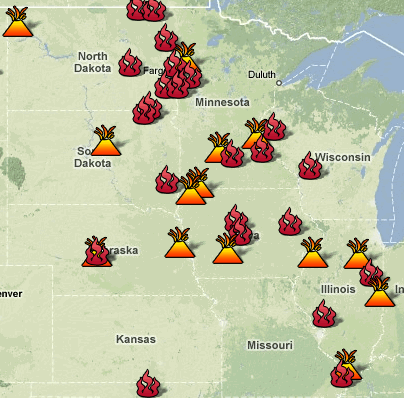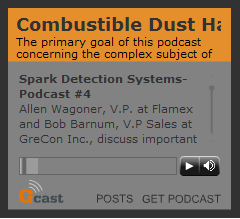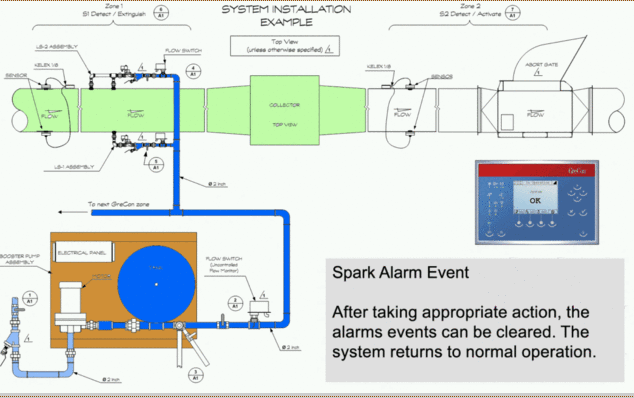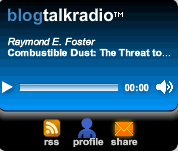
The recent
grain elevator explosion in Louisiana last week brought back stark memories of over three decades ago, in 1977, when a series of similar dust explosions occurred in grain elevators throughout the south, which resulted in dozens of workplace fatalities. Fortunately in the recent explosion no injuries or fatalities were reported, just a lot of frayed nerves from nearby residents with electrical service briefly interrupted along the Mississippi River.
30 Combustible Dust ExplosionsOver the past year, through media accounts, 30 combustible dust related explosions have occurred in the wood, food, chemical, metal, plastic, rubber, utility, and paper manufacturing sectors. On the western bank of the meandering Savannah River, workers weren't so lucky in escaping injuries or fatalities on the evening of February 7, 2008 when a catastrophic Imperial Sugar Refinery dust explosion occurred in Port Wentworth, Georgia. Subsequently, national media coverage created a much needed awareness concerning combustible dust hazards in the workplace.
Additionally, intense outrage amongst Democratic Congressional leaders responded with an emotionally drafted general industry
combustible dust bill, which passed in the House, and now awaiting vote in the Senate. Results of the presidential election, with a potential shake-up of public policy concerning workplace health and safety will determine the future of the bill.
118+ Fires and ExplosionsUnfortunately this year, the Imperial Sugar dust explosion was not an isolated incident. For instance over the past year, through media accounts, 118+ combustible dust related fires and explosions have occurred in the manufacturing, utility, and non-manufacturing sectors.
Trying to make sense of it all and why even dust explodes is an exercise in science combined with business and public policy across the vast ocean of the public and private sectors. The on-going tug of war between the interests of big business and labor complicates the matter even further in arriving at a cost effective solution in preventing future fatalities, injuries, and adverse economic damage.
Cursory Solution : Incomplete DataOf major concern is how can public policy be created in Congress with ensuing OSHA health and safety regulation's if the extent of the problem is not completely evaluated? Costly governmental studies were completed, which resulted in federal directives that only provide a cursory solution to the combustible dust problem. In the meantime our nation's infrastructure in the manufacturing base is at threat from continuing preventable combustible dust related fires and explosions.
For instance the
OSHA Combustible Dust National Emphasis (NEP) program is not even required in nearly half of the states with
State OSHA Plans (strictly voluntary). That's only the tip of the iceberg, especially over the past year, where explosions and fires are occurring at facilities with dozens of NAICS not listed in the NEP.
Food ManufacturingReviewing the
food sector, six out of the seven combustible dust explosions occurred in national food industries (NAICS) not listed in the NEP. With explosions occurring more than once at dehydrated food and evaporated diary product manufacturing plants. This is where a ComDust Hazard Alert goes out next, especially when these industries are not on the NEP radar. OSHA inspectors are actively inspecting these facilities as the following excerpt from a recent
General Duty Clause (GDC) citation at a dehydrated food manufacturing plant in Wisconsin will illustrate:
"...The following C.O.W (cream of wheat) equipment did not have explosion/deflagration containment, suppression, inserting, or venting protection: a) Cooker room dust collector, approximately 375 cubic feet, was located inside the building lacking explosion venting. b) silo did not have explosion venting. d) pneumatic conveyor did not have spark detectors or propagation shut off devices to prevent explosion propagating forward or aft. "AMONG OTHER METHODS, ONE FEASIBLE AND ACCEPTABLE ABATEMENT METHOD TO CORRECT THIS HAZARD..."Overall, out of the 17 combustible dust related fires and explosion in the food sector, over 70% happened at facilities not listed in the OSHA Dust NEP. Are we seeing a trend here?
Paper Product ManufacturingA glance at the
paper manufacturing sector which includes 16 national paper industries (NAICS), not one is listed in the OSHA Dust NEP. So how many explosions and fires this year? How about 11 fires and explosions, which included two dust explosions. It's like a snowball rolling down the hill as the plot gets bigger and bigger with four paper mill combustible dust related fires, three sanitary paper product manufacturing fires, and two combustible dust fires at corrugated solid and fiber box manufacturing plants.
Plastics/Rubber Product ManufacturingIn all fairness the
plastics and rubber manufacturing sector is well covered in the NEP. For example, seven combustible dust fires and explosions occurred this year which includes three explosions. There does need to be a reevaluation of whether these national plastic/rubber industries have a
potential /D-2 or more
frequent/D-1 history of combustible dust fires/explosions as outlined in appendix D-1 and D-2 of the NEP. All these explosions occurred in NAICS that were referenced in
D-2 (potential for an incident). If incidents are reoccurring with explosions then wouldn't that move them from a
potential/D-2 to a
frequent/D-1 in the Appendix?
ConclusionOther sectors in wood, chemical, textile, machinery and metal national industries have their share of explosions and fires as depicted in the chart for incidents in 2008. Stakeholders with financial interests in all these manufacturing and non-manufacturing sectors must understand that the OSHA Combustible Dust NEP is solely a directive which provides guidelines for OSHA inspectors in conducting enforcement and inspection actions at facilities.
It should not be used as guidance in preventing and mitigating future incidents, while misinterpreting that since your facility is not a listed NAICS in the NEP, you are out of danger from the hazards of combustible dust. Over 50% of the combustible dust explosions this year were at facilities with NAICS (national industries) not listed in the NEP. Don't be a statistic. As soon as possible initiate a process hazard analysis which identifies, evaluates, and controls the inherent combustible dust hazards at your facility.
For additional information if your national industry has a history of potential or high occurrence of combustible dust related fires/explosions contact John Astad at the Combustible Dust Policy Institute.





















 RSS Feed Subscribe
RSS Feed Subscribe